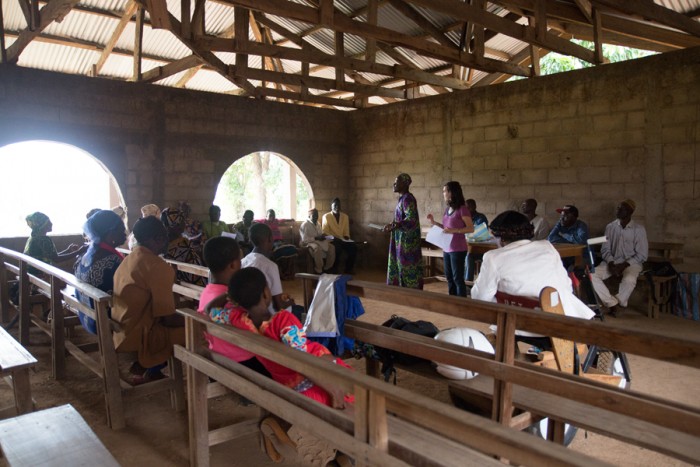March 9th, 2016 by Rachel | Tags: Disability, HIV/AIDS, Peace Corps | No Comments »

Rachel and Samuel present HIV Prevention to a large group of persons with disabilities in Kedjom Keku.
In the past couple weeks, I gave three additional HIV Prevention workshops to persons with disabilities. I traveled to an area called “Bamenda I.” While this area is still part of the city of Bamenda, it’s located far from the center of the city and is on the outskirts. I presented to a large group of persons with disabilities. At this workshop, it was clear that almost all paricipants have been well educated in HIV Prevention because everyone except for one person scored 78 percent or higher on the pre-test. A couple people did say that sharing clothes and/or hugging people can cause HIV transmission on the pre-test. However, on the post-test, every single participants marked “false” that HIV can be transmitted through sharing clothes and hugging. This demonstrated this myth has been well clarified at the workshop. One participant scored 44% on the pre-test and then scored 89% on the post-test which shows that the participant has demonstrated a tremendous improvement in the knowledge of HIV prevention.
Then, a few days later, I presented to the visually impaired group in Bamenda. This was a group of nothing but very high intelligent and well educated persons with disabilities. According to one member of the group, most members are or were university students which explains why they already demonstrated good understanding of HIV prevention. Everyone scored 89% or 100% except for two who scored 78% on both the pre-test and post-test. Almost no one believed in the myths of HIV being transmitted through sharing clothes and hugging people. Even when I asked what what HIV and AIDS stood for and what were the causes of HIV, participants were able to verbally answer the questions correctly. This group represented a good example of how education can make a difference in one’s knowledge about health.
This past Sunday, Samuel and I traveled to Kedjom Keku, a village in Northwest that was located about an hour outside of Bamenda. We presented to another large group of persons with disabilties. Half of the participants reported having never learned HIV in the past when I verbally asked them if they have learned about HIV in the past. On the pre-test, four participants scored 100 percent and the rest scored 89 or 78 percent. It’s important to note that many of those who scored 78 percent circled “true” for every single answers, which is to say that the participants probably knew nothing. Several participants reported both on the pre-test and verbally that HIV can be transmitted through sharing clothes and hugging. On the post-tests, every single participants except for four scored 100%. Those four scored 89 percent. Only one reported on the post-test that HIV can be transmitted through hugging. This means that at this workshop, I was able to really clarify the myths.
As a matter of fact, because this was Samuel’s only second time being present with me at an HIV Prevention workshop, he was completely shocked to learn how many persons with disabilities believed that HIV can be transmitted through sharing clothes and hugging, and said, “Did they really believe in this?” He said he couldn’t understand and thought they should have already understood that HIV can be transmitted only through sexual intercourse, sharing needles, blood transfusion, breastfeeding, or pregnancy labor. The first time he was present with me was at the visually impaired group, a group who already understood so well about HIV/AIDS simply because they had education. However, majority of the participants in Kedjom Keku likely have never been to school, which is likely the reason why they lacked the knowledge in how HIV is transmitted.

Samuel was surprised to learn how many persons with disabilities believed in certain myths relating to HIV transmission.
